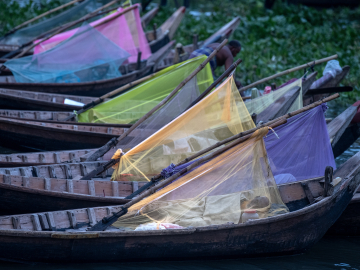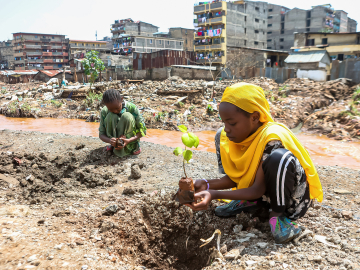Q&A with Amy Maxmen: An Unjust Problem
Freelance journalist Amy Maxmen in a village talking with a mycetoma researcher (left) and women in the village in central Sudan. Image courtesy of Neil Brandvold/DNDi.
Freelance journalist Amy Maxmen has written about everything from the DNA editing tool Crispr, to nurses in Sierra Leone who fought Ebola without pay, to the world’s oldest graveyard in Ethiopia and the neuroanatomy of sea spiders. (That last one was part of her research for her PhD in Organismic and Evolutionary Biology at Harvard.)
Still, in the disease mycetoma, she found something new… and horrible.
In this Q&A, Maxmen, who has published articles in Wired, The Lancet, Nature, Nautilus and The Economist, shares her challenges, surprises and hopes for the series on mycetoma. —Brian W. Simpson
Why did you want to take on this story?
When you told me about this story, it definitely sounded interesting. I Googled it, and it is clearly a horrible disease—I looked at photos of feet 3 times their normal size. Mycetoma afflicts people without a voice, and it is unjust that people don’t care about this disease. That said, just because an issue is important doesn’t mean it makes for a compelling story that people will read. And as a writer, I want people to read my stories.
However, I got more interested at the World Health Assembly in Geneva [in May 2015] when I met Professor Ahmed Fahal of the Mycetoma Research Center in Sudan. He looked sort of depressed. He was visibly upset. What had happened was that just a few hours before we met he had learned that mycetoma would not be added to the agenda for discussion at the meeting. He had flown all the way to Geneva in hopes of that happening, and at 8 a.m. Monday morning he was told that they would not even bring it up. He was crushed.
That’s when I became more interested. It’s moving to see someone who is deeply invested in an unjust problem. Now this important topic started to become a story with characters.
What was it like in Sudan?
Sudan was not at all what I expected. It was remarkably safe in Khartoum and the people so were so hospitable. People were bending over backwards to be kind and inviting me to come over to lunch, offering me car-rides places, telling me what I should see or do while I was in town.
In terms of science, Sudan (especially Khartoum) is better off than many of the places I’ve been to in sub-Saharan Africa. The Mycetoma Research Center has a machine for PCR. It has refrigerators and freezers that stay on because the electricity is reliable. With a long distinguished history, scientists were well positioned to handle not only mycetoma but other diseases. However, Sudan is in a hard economic position because of lost oil revenue from South Sudan. That means scientist and doctor salaries are getting lower and lower. And US sanctions prevent collaboration that would otherwise happen.
You’ve reported on Ebola and other tough issues before. How did reporting on this story affect you?
I had moments when I thought about how this is just a little fungus, like athlete’s foot is a fungus, so it should never get as bad as it does in Sudan. There it was not unusual to see patients with huge, grotesquely swollen limbs or amputated limbs.
Professor Fahal had a cross-section of a foot in formaldehyde. It was completely filled with fungus that had eaten away at the bone. It reminded me of illustrations I have seen of cross-sectioned nests from leaf cutter ants. They farm fungus, and the nests are full of chambers packed with fungi. Advanced mycetoma infection looks the same but it is in a human body.
What’s behind the lack of attention to mycetoma?
There’s a few things in play. All the neglected diseases are diseases that almost exclusively affect the very poor. That means Big Pharma is reluctant to develop drugs for them. And since there’s no real risk of a mycetoma outbreak in the US or the UK, agencies like the U.S. Department of Defense don’t fund research because they don’t see it as a threat in the way they see Ebola, MERS and SARS.
Does the low mortality rate play a role in the lack of attention? It’s not a killer like malaria or TB.
Definitely. This is a disease that is a slow killer if it kills. It causes disability that gets worse and worse. Mycetoma patients have to quit their work, they have to quit school. They have to be supported by other people—especially if they have a limb that is amputated. It’s destructive to the family and the economy of the entire village. But you can’t say it kills a person within a week, which is a simple and powerful statement that gets people’s attention.
What’s your hope for the series?
I would be delighted if scientists read it, or a grad student read it and decided to study mycetoma. It would be even better if a funding agency would decide to put out a call for proposals to find out the burden of this disease, or to answer many other unknowns about its pathology.
And right now, the handful of scientists who do work on mycetoma work are really pushing the WHO to put it on the list of neglected tropical diseases. If mycetoma is added to the list, then big funding agencies like the Gates Foundation might feel compelled fund research into it.
If anything like that happens, I would be so happy.
Any last thoughts?
I think what you have done is kind of cool. I really do. It’s kind of neat and sadly novel for a news agency nowadays to do a story just because they think it is important and not worry about the clicks. I would love it if that happened more often.
Part I: Flesh-eating Fungus Wrecks Lives and No One Cares
Part II: First Step for a Dreadful Disease: Get on the List
Part III: The Opposite of Martin Shkreli: Drug Development Without Profit
Please join the thousands of subscribers who rely on Global Health NOW summaries and exclusive articles for the latest public health news. Sign up for our free weekday enewsletter, and please share the link with friends and colleagues: Subscribe to GHN





